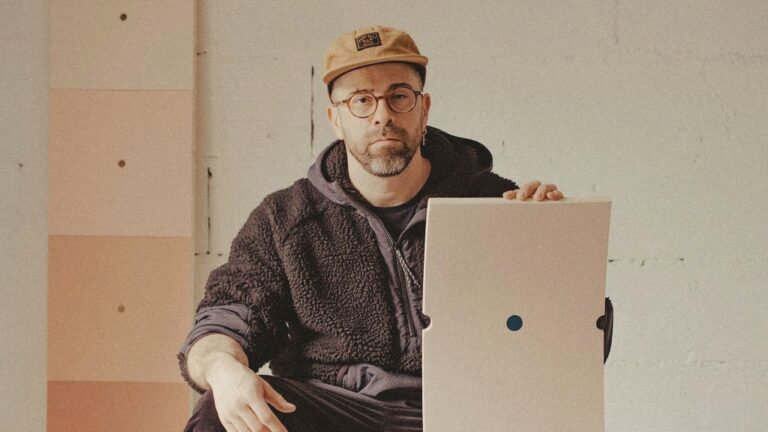
A Conversation with Alejandro Javaloyas
A Studio Visit During the La BIBI Residency
Performance Art, a dynamic mode of artistic practice, involves individuals or groups enacting actions within defined temporal and spatial contexts observed by an audience. Central to its execution is the live presence of the artist and the corporeal actions of their body, thus yielding an ephemeral artistic experience. A pivotal tenet of Performance Art is the human body, regarded as the fundamental medium and conceptual substrate upon which its edifice rests. Essential components encompass temporal dimensions, spatial parameters, and the intricate interplay between performer and spectator.
With a multidisciplinary orientation, although Performance Art draws elements from theatrical forms, it deviates from conventional narrative structures, often incorporating various media and other art forms. Performances span an array of manifestations, from impromptu acts to meticulously rehearsed endeavors and collaborative configurations. Notably, Performance Art uniquely positions visual artists as both the performers and the creators, reshaping the conventional production model. The space where the performance takes place is tremendously versatile as it does not allow to be pinned down in one particular context, ranging from traditional art spaces such as museums and art galleries to the street, bars, or even in a person’s home.
One could argue the roots of Performance Art go back to medieval performers, think of poets, minstrels, and jesters—although this discourse is a rather a posteriori construction, as it was a performance as general entertainment and not as art. Its actual inception is most commonly linked to early 20th-century Avant-Garde movements like Futurism, Constructivism, Dada, and Surrealism. Performance was happening with Avant-Garde and experimental theater. Yet, the power of performance in art was predominantly discovered in the mid-20th century, when the artist’s gesture was celebrated and documented with Abstract Expressionism and, in particular, Action Painting, indirectly paving the way for Performance Art.
The late 1950s and early 1960s witnessed the emergence of both Minimal Art, followed by Conceptual Art, radically and ingeniously redefining art. Happenings—multidisciplinary events emphasizing chance and audience involvement—and Fluxus artists who blurred distinctions between art and everyday life emerged, further evolving the genre. There was also the Gutai Art Association in Japan in the 50s, occupied with performance, followed by the Viennese Actionism in the 60s. However, Performance Art only became a true art movement, and prominent terminology, via the 1960s’ socio-cultural shifts prompted artists to challenge the commercialization of art, leading to new practices rooted in feminism, post-colonialism, and critical theory. As a result, Performance Art embraced ephemeral, didactic, and text-based works that questioned art’s commodification, escaping the commercial and decorative character and focusing on the performance, dematerializing art in a similar vein as Conceptual Art.
In traditional art forms, the object is the artwork. In Conceptual Art, the idea becomes the artwork. And, in Performance Art, the performance is the artwork.
By the 1970s, the term “Performance Art” gained prominence, aligning with Conceptual Art’s emphasis on ideas over objects. This resonated with artists aiming to disrupt art’s material norms. The body was the medium, and the artwork’s existence was only temporary. The subsequent decades have ushered in a surge of artist-led initiatives and alternative spaces, pushing the boundaries of Performance Art. Categories like Activist Art and Body Art emerged, addressing sociopolitical concerns and reshaping notions of the human body. Performance Art’s progression was fueled by photography, film, and video, enabling documentation and reaching wider audiences. Incorporating technological elements, like sound and digital media, further expanded the medium’s horizons. While Performance Art initially challenged traditional venues, it now frequently unfolds within museums and galleries. Questions about preservation, presentation, and reimagining its temporality arise as it traverses these institutional spaces.[2]
Numerous organizations, festivals, and training programs dedicated to Performance Art continue to shape its evolution. Still, in particular, the impelling force behind all of this are, of course, the artists—the true pioneers of Performance Art. Therefore, for a greater understanding of Performance Art, let us tackle the most important Performance artists and artworks by reciting and discussing a reasoned selection of thirty iconic artists, using the Artfacts algorithm to measure their influence and importance using objective data and career facts.[1] Please note we have excluded some artists who have been active in performance but are predominantly occupied or linked with a different art form or movement to ensure our selection is focused on Performance artists pur sang—think of Robert Rauschenberg, who is primarily a painter, or John Baldessari, whose performance-based works are Conceptual artworks, Nam June Paik who is mainly seen as a Video and Installation artist but includes some performance-related activities, or Gilbert & George and their singing sculpture. Even more, we intend to go beyond the usual suspects of the historical era of Performance Art and update its canon, introducing prominent performance artists from the past few decades.
For further reading, we strongly recommend the reference publication by Catherine Wood, discussing the history of Performance Art, published by Tate.
Dennis Oppenheim (1938-2011) emerged as a prominent American artist renowned for his diverse creative endeavors encompassing Conceptual Art, Performance Art, Land Art, sculpture, and photography. Born in Electric City, Washington state, he explored art by delving into sculpture experimenting with rudimentary engines and kinetic components. Following his education at the California College of the Arts and Stanford University, Oppenheim relocated to New York in 1966, establishing a residence, studio, and a team of assistants.
Oppenheim’s artistic spectrum encompassed writing, action, performance, video, film, photography, and installations, often employing mechanical and industrial elements, commonplace objects, and materials from the natural world. His portfolio traversed interior, exterior, and public domains. Notable performances include Parallel Stress (1970), Two Stage Transfer Drawing (1971) in collaboration with his son, and Disappear (1979).
Oppenheim’s legacy was further embellished by accolades, including a Guggenheim Foundation Fellowship (1969), National Endowment for the Arts Fellowships (1974, 1982), an Excellence in Transportation Award from California (2003), and a Lifetime Achievement Award at the Vancouver Sculpture Biennale (2007). His final creation, “Swarm” (2011), stands as a testament to his multifaceted oeuvre and is located at Norwalk Community College in Connecticut. Dennis Oppenheim’s demise in 2011 marked the conclusion of a prolific artistic journey that left an indelible impact on contemporary art.[3]
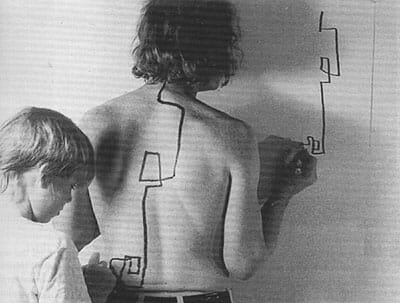
Carolee Schneemann (1939-2019) was a pioneering American artist known for contributing to Feminist Art, Performance Art, and multimedia experimentation. Born in Fox Chase, Pennsylvania, Schneemann emerged as a groundbreaking figure whose boundary-pushing works challenged conventional norms and redefined the intersections of Body Art and activism. Schneemann’s journey into art started at Bard College and the Columbia University School of Fine Arts, where she honed her craft in painting and the visual arts. However, her artistic trajectory transformed as she delved into Performance Art during the 1960s. Through her innovative performances, Schneemann left an indelible mark on the art world with some of history’s most controversial and iconic performances.
A defining aspect of Schneemann’s practice was her radical approach to the human body as both subject and object. Her performances embraced physicality, often involving nudity and visceral engagement, aiming to dismantle traditional norms and challenge the objectification of the female form. In her groundbreaking performance “Meat Joy” (1964), Schneemann orchestrated a chaotic spectacle of bodies, paint, raw fish, and other tactile elements, blurring the lines between performance, sculpture, and dance. This work captured the raw essence of embodiment and liberation, becoming emblematic of her artistic ethos.
Schneemann’s exploration of gender dynamics and the female experience was evident in her iconic performance piece “Interior Scroll” (1975). In this work, she extracted a paper scroll from her vagina, unfurling it to read aloud a feminist manifesto challenging the perception of women as passive objects. This evocative act confronted societal discomfort and opened discourse on female agency, sparking conversations about representation and autonomy within the art world. Carolee Schneemann’s legacy extended beyond Performance Art, encompassing painting, film, and multimedia installations. By intertwining performance with her broader oeuvre, Schneemann left an enduring imprint on the trajectory of contemporary art, heralding a new era of artistic expression and social critique.[4]
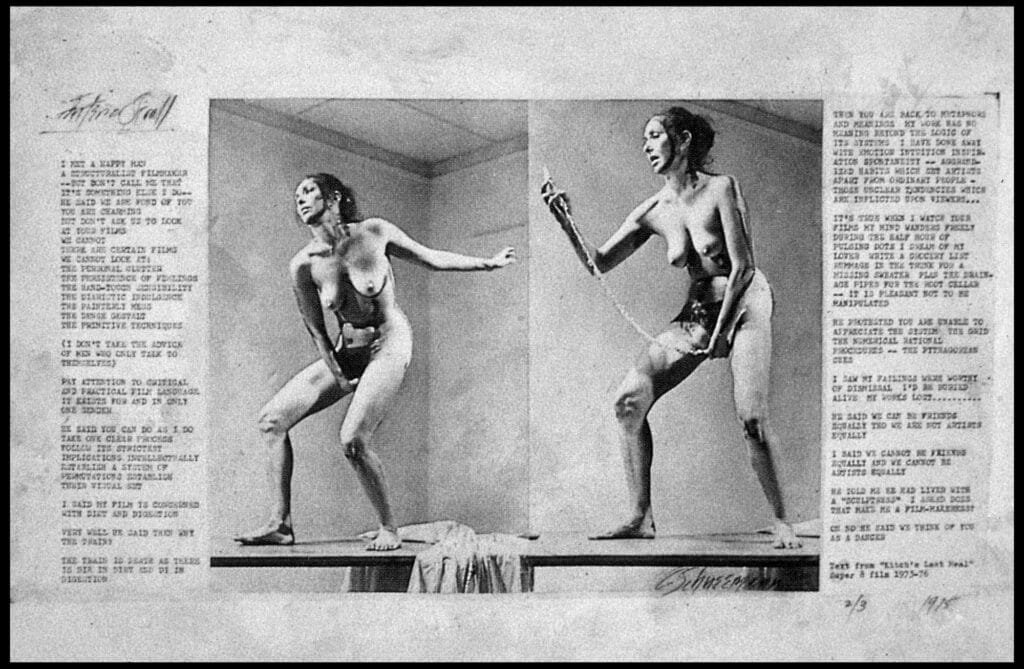
Born in 1948 in New York City, Adrian Piper has seamlessly merged personal narratives with thought-provoking political discourse. Piper’s educational path led her to an A.A. from the School of Visual Arts in 1969, a B.A. from the City College of New York, and a Ph.D. from Harvard University in 1981—her philosophical focus centers on ethics, with a particular lens shaped by the writings of Immanuel Kant. Notably, Piper achieved a significant milestone by becoming the first African American woman to attain tenure in philosophy at Georgetown University in 1987, solidifying her reputation as a distinguished Kant scholar.
During the late 1960s, Piper’s association with Sol LeWitt prompted her to explore the conceptual dimensions of art creation. This influence propelled her towards a series of thought-provoking performances characterized by their audacious and politically charged nature. The “Mythic Being” series (1973-75) witnessed Piper donning a male persona, complete with an Afro and mustache, as she recited passages from her own journals while traversing the streets of New York City. “Funk Lessons” (1982-84) involved lectures that educated predominantly white audiences about the historical context of the musical genre, followed by dance instruction. One of her most recognized endeavors, “My Calling (Card) #1: A Reactive Guerrilla Performance for Dinners and Cocktail Parties” (1986-1990), saw Piper distributing printed notes to individuals who had unintentionally offended her, featuring a powerful opening line that asserted her racial identity.
Piper’s substantial contributions have garnered her esteemed fellowships, including recognition from the Guggenheim, the National Endowment for the Arts, and the Andrew W. Mellon. Her impact is underscored by accolades such as the Women’s Caucus for Art Lifetime Achievement Award (2014) and the Venice Biennale Golden Lion Award for Best Artist (2015). Notable art institutions including the Metropolitan Museum of Art in New York, the Museum of Contemporary Art in Los Angeles, and the Centre Georges Pompidou in Paris house her works. The 2018 retrospective, “Adrian Piper: A Synthesis of Intuitions, 1965-2016,” hosted by the Museum of Modern Art, NY, stands as a testament to her enduring influence on both the art and philosophical spheres.[5]
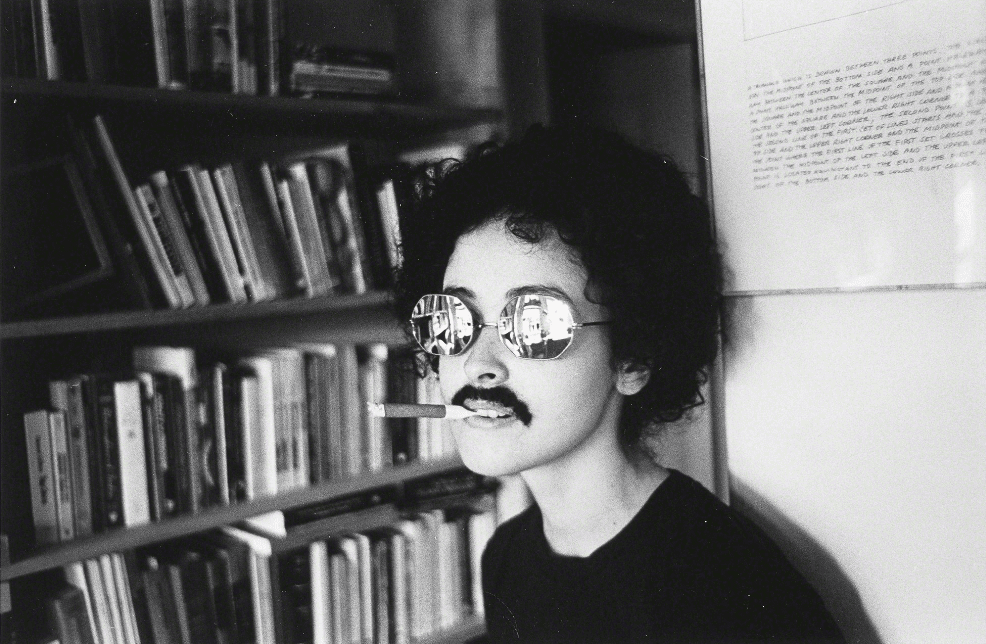
Born in The Bronx, New York, Vito Acconci (1940-2017) is a performance, video and installation artist, whose artistic journey was marked by an unorthodox approach to exploring the boundaries of human interaction, space, and the self. He emerged during the late 1960s, a period marked by social and cultural upheaval, as he gained recognition for his groundbreaking performances that pushed the limits of traditional art forms, blurring the line between art and life, employing the body as a medium to communicate ideas, emotions, and experiences.
One of Acconci’s most significant performance artworks is Seedbed (1972). In this provocative piece, the artist lay hidden beneath a wooden ramp in a gallery, masturbating while uttering explicit fantasies about visitors walking above him. This work highlighted the intimate connection between the artist’s body and the viewers’ presence, creating an unsettling but thought-provoking engagement that challenged notions of voyeurism and public space. Another notable performance, Following Piece (1969), involved Acconci following strangers through the streets of New York City until they entered a private space, at which point he would choose a new subject. This act explored the dynamics of surveillance, consent, and the boundaries between public and private spheres, inviting viewers to reconsider their relationship with both urban environments and personal autonomy.
Acconci’s artistic practice was characterized by its interdisciplinary nature, as he expanded beyond performance into various mediums, including video, installation, and even architecture and design. His work consistently delved into psychological and social territories, often confronting uncomfortable subjects and probing the viewer’s response. His architectural designs were often characterized by their innovative approaches to space, blending functionality with conceptual ideas. Vito Acconci’s contributions to performance art remain significant today, as his thought-provoking works challenged established norms and pushed the boundaries of artistic expression.[6]
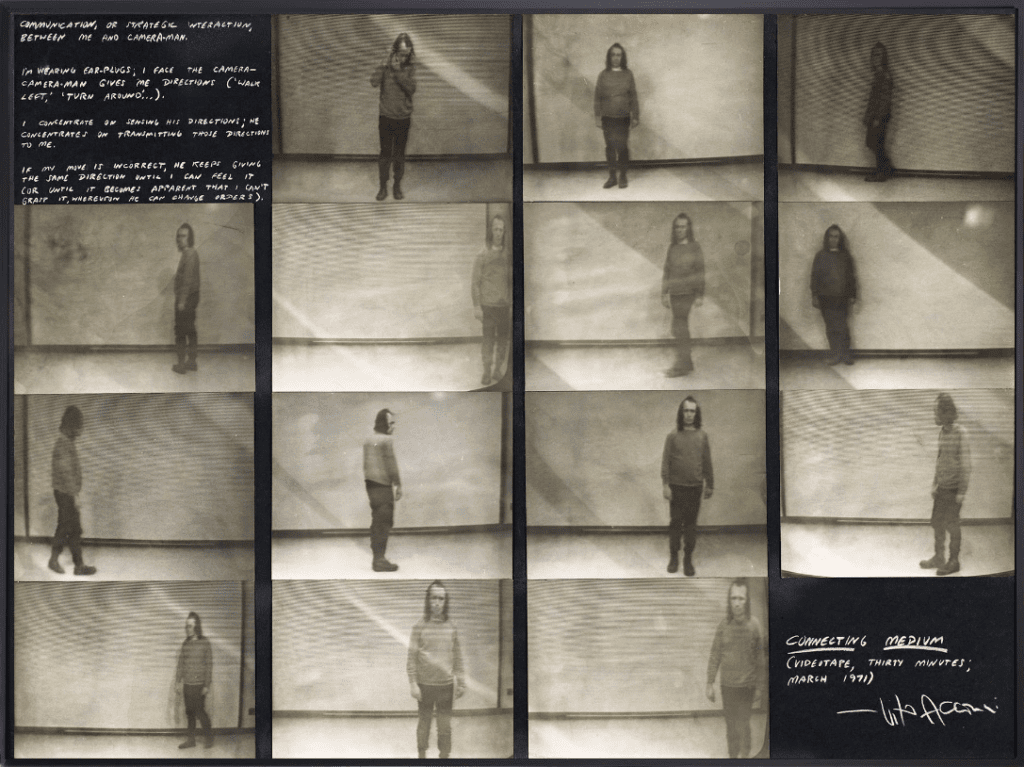
Wolf Vostell (1932-1998) was a visionary German artist renowned for his pioneering contributions to the Fluxus movement and innovative works that bridged the gap between art and daily life. Born in Leverkusen, Germany, Vostell’s artistic journey was marked by his commitment to pushing boundaries and redefining artistic norms. His impactful happenings and immersive performances challenged conventional perspectives, prompting audiences to question societal norms and explore the intersections between art and the urban environment. Beyond performances, Vostell’s artistic legacy encompassed sculpture, assemblage, collage, and décollage techniques.
At the heart of Vostell’s artistic endeavors were his captivating happenings, an art form that ignited cultural conversations and encouraged audience engagement. These immersive experiences transcended the confines of traditional gallery spaces, taking art to the streets and public spaces. Cityrama (1961), a groundbreaking happening in Cologne, exemplifies Vostell’s mastery in merging the urban landscape with artistic expression. This dynamic event featured a bus tour through the city, with windows covered in canvas, onto which paintings were projected, intertwining visual art with the urban environment.
One of Vostell’s most influential happenings was Sun in Your Head (1963-1966), a groundbreaking exploration of multimedia and technology. This performance harnessed television screens, live performers, and music to create a multi-sensory experience that captivated audiences. Throughout his prolific career, Wolf Vostell demonstrated an unwavering commitment to pushing artistic boundaries, embracing the Fluxus spirit, and creating immersive happenings that resonated with audiences on both intellectual and emotional levels. His legacy inspires contemporary artists who seek to challenge the conventional and redefine the boundaries of artistic expression.[7]

Born in 1944 in Michelstadt, Germany, Rebecca Horn is a visionary artist whose creative journey has unfolded through a dynamic flow of performances, films, sculptures, spatial installations, drawings, and photographs. Rooted in precision and technical functionality, her works engage with space in ways that challenge traditional boundaries. Horn’s journey begins with her body-extension performances, exploring the intricate equilibrium between the human body and its surroundings. As her artistic evolution progresses, she introduces kinetic sculptures that take on lives of their own, emancipating themselves from the human form. Mirrors, light, and music become her tools for redefining and reshaping spaces, creating experiences that transcend the visual realm.
A distinctive hallmark of Horn’s installations lies in her choice of objects. Suitcases, pianos, metronomes, and more come together to form kinetic sculptures that defy conventional materiality. These sculptures evolve into ever-changing metaphors, weaving connections with mythology, history, literature, and spirituality. Horn’s artistic journey is marked by an organic consistency, where each new work logically builds upon its predecessor. Themes and elements may resurface but within new and divergent contexts, creating a dynamic narrative that unfolds over time. Her early physical performances, including body extensions and feather objects—think of the Finger Gloves (1972) performance—culminate in kinetic sculptures featured in her films.
The 1980s and 1990s witnessed monumental installations emerging from spaces of political and historical significance. Kinetic sculptures become vehicles for reinterpreting the weight of the past within these spaces, infusing them with fresh perspectives. Monumental towers, mechanically playing violins, and immersive installations illuminate poignant narratives of remembrance and transformation. Horn’s artistic expression continues to evolve, embracing energy as a magnetic flow. Her recent works transcend corporeal boundaries, transforming into an ethereal embodiment of space charged with newly generated energy.[8]
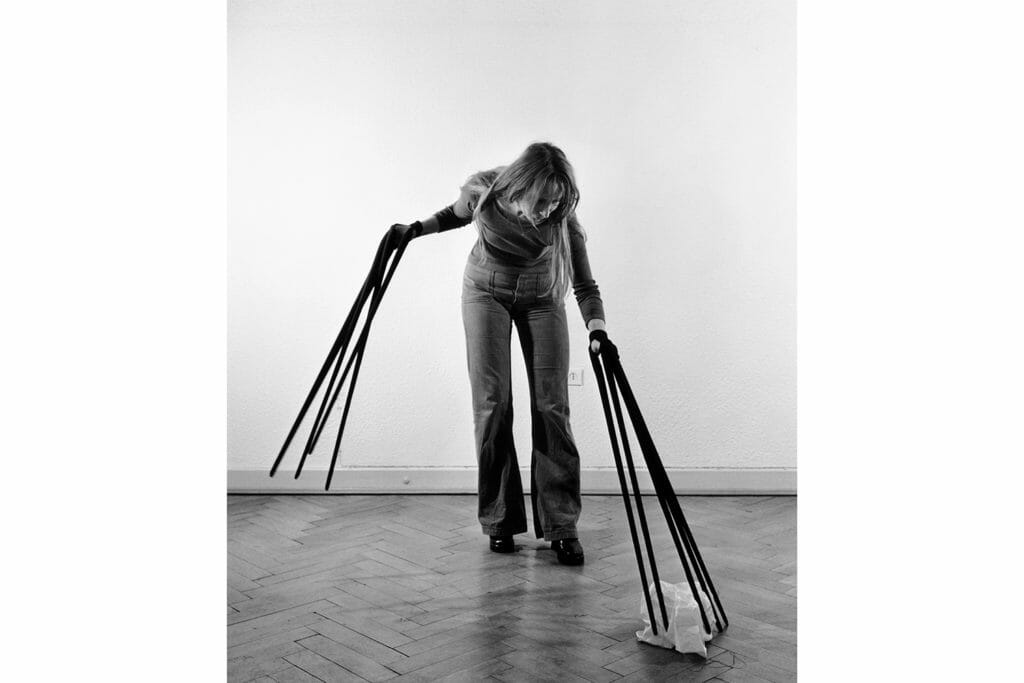
Ragnar Kjartansson, born in 1976 and based in Reykjavík, is a multi-faceted artist who seamlessly navigates various artistic disciplines, including video installations, performances, drawings, and paintings. His creations draw upon a rich frame of reference of historical and cultural quotes, interweaving an underlying pathos and irony that resonate throughout. Influenced by the dualities of classical theater—the interplay between comedy and tragedy—Kjartansson’s works blur the lines between mediums.
He approaches painting as a form of performance, likens his films to painterly canvases, and treats his performances as sculptural expressions. His artistic practice is a fluid dance across these mediums, linked by a fascination with beauty’s complexity and banality. Notably, Kjartansson employs durational and repetitive performance as a method of exploration. Think of his performance piece Scared Man (2023), in which a tuxedo-clad man with his back to the wall stands scared and perched on a cornice—a Hollywood cliché that is both humorous and disturbing.
Kjartansson’s body of work has made waves on an international scale, with major solo exhibitions gracing prestigious institutions worldwide. His pieces have graced venues such as the De Pont Museum in Tilburg, the Kunstmuseum Stuttgart, The Metropolitan Museum of Art in New York, the Reykjavík Art Museum, the Barbican Centre in London, and the Hirshhorn Museum and Sculpture Park in Washington D.C. Among others, he has also exhibited at the Musée d’Art Contemporain de Montréal, the Palais de Tokyo in Paris, the New Museum of Contemporary Art in New York, and the Carnegie Museum of Art in Pittsburgh. Kjartansson’s notable appearances include participation in the Venice Biennale’s The Encyclopedic Palace in 2013 and Manifesta 10 in St. Petersburg in 2014. His contributions extend to representing Iceland at the 2009 Venice Biennale.[9]
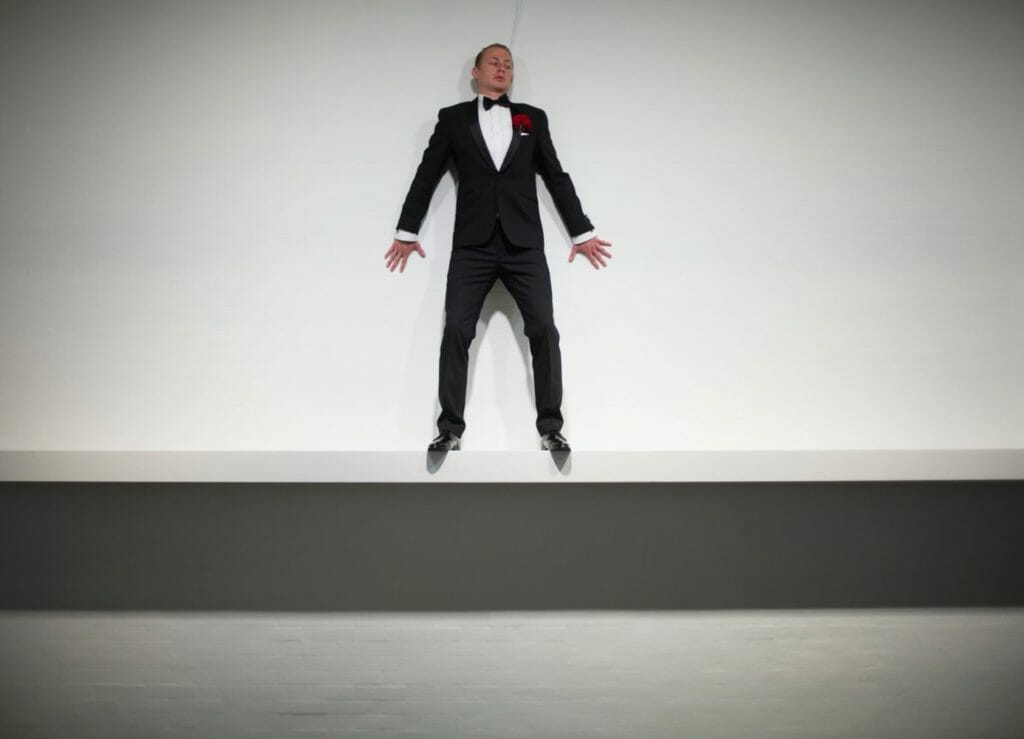
Based in Chicago, Theaster Gates is a multidisciplinary artist working in land development, sculpture, and performance. With a profound urban planning and preservation background, Gates breathes new life into forgotten spaces, imbuing them with significance and vitality. His artistic mission revolves around the notion of “life within things,” a concept he masterfully realizes through his innovative practices.
Gates possesses a unique ability to recalibrate art-world capital, land values, and human values. Through his work, he orchestrates a captivating dialogue between these interconnected realms, redefining their dynamics and relationships. Central to his artistic philosophy is the concept of Black space, which he treats as a formal exercise. This form of space is characterized by collective desires, artistic agency, and the strategic approaches of a pragmatic visionary—as exemplified in his performance The Black Monks of Mississippi (2017).
Throughout his prolific career, Gates has exhibited and performed on a global stage, leaving an indelible mark on the art world. His work has graced esteemed venues such as the Palais de Tokyo in Paris, France; Sprengel Museum Hannover in Germany; Kunstmuseum Basel in Switzerland; National Gallery of Art in Washington D.C., USA; Art Gallery of Ontario in Canada; Fondazione Prada in Milan, Italy; Whitechapel Gallery in London, UK; and Punta della Dogana in Venice, Italy. His participation in dOCUMENTA (13) in Kassel, Germany, further solidified his reputation as a visionary artist.[10]
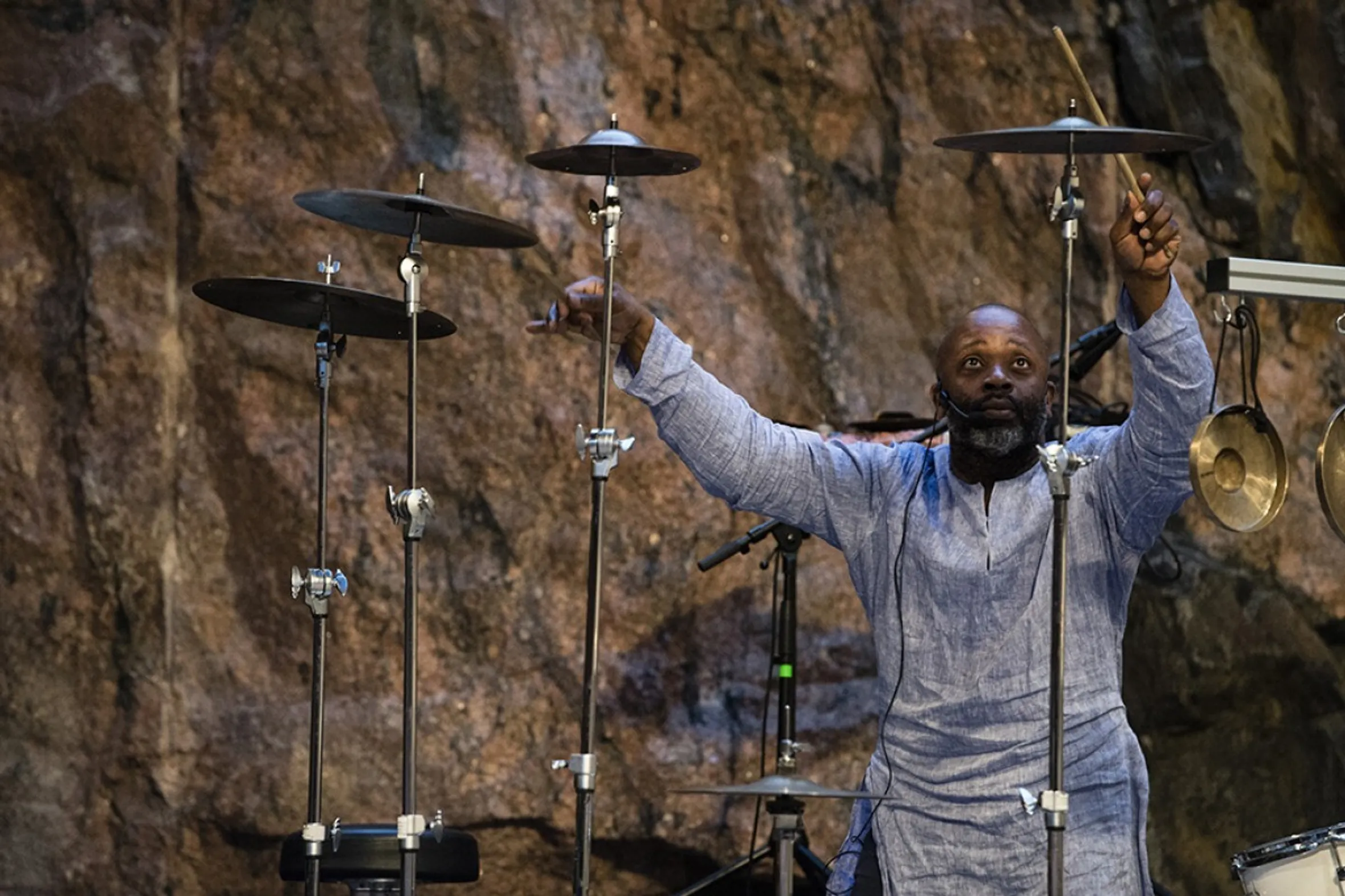
John M. Armleder, born in 1948 in Geneva, Switzerland, is a contemporary artist working in painting, sculpture, installation, and performance, infused with a remarkable sense of humor and conceptual innovation; a dynamic interplay between various artistic influences has marked his career. Armleder’s creative trajectory began with the Groupe Ecart in Switzerland, where he cultivated his artistic voice amidst a productive tension. This early engagement set the tone for his subsequent endeavors, which included collaborations with the Fluxus movement.
His association with Fluxus, along with a deep admiration for John Cage’s work, greatly informed his projects. Operating on multiple artistic fronts, Armleder draws inspiration from seemingly divergent movements such as Dada and Abstract Expressionism. His approach to each exhibition is marked by uncompromising dedication, resulting in unpredictable yet impactful creations. His exhibitions become unique, self-contained works imbued with his characteristic blend of wit, provocation, and audacious experimentation.
Armleder’s influence is showcased through numerous solo exhibitions hosted worldwide. Recent years have witnessed his solo presentations at esteemed institutions like the Rockbund Art Museum in Shanghai (2021), KANAL – Centre Pompidou in Brussels (2021), Aspen Art Museum in Colorado (2019), Schirn Kunsthalle Frankfurt in Germany (2019), and Museo Madre in Naples, Italy (2018), among others. His work graces the permanent collections of renowned museums, including the Centre Pompidou in Paris, the Getty Research Institute in Los Angeles, the Kunstmuseum Basel in Switzerland, the Museum of Modern Art in New York, and the Louisiana Museum of Modern Art in Denmark. Armleder’s impact transcends borders, firmly rooted in his hometown of Geneva.[11]
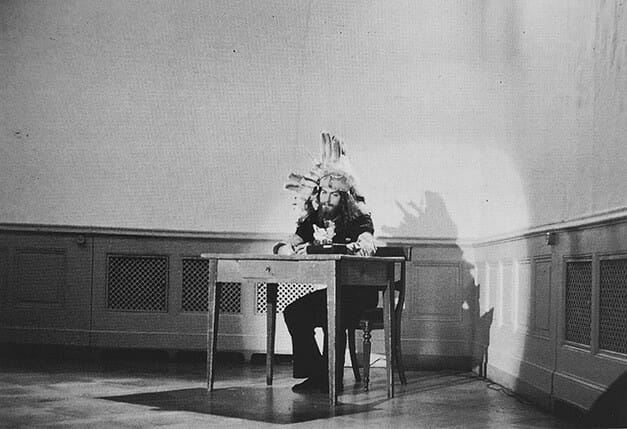
Chiharu Shiota, born in 1972 in Osaka, Japan, resides and works in Berlin and seamlessly blends performance, body art, and installations, weaving a complex oeuvre that celebrates the human form and its profound connections. At the heart of Shiota’s artistic process lies a profound exploration of the body, where the intertwining of yarn becomes a metaphor for the intricate web of life. Her transformative approach bridges the realms of temporality, movement, and dreams, inviting viewers into an immersive experience.
Shiota’s art calls for a dual engagement, engaging physically and emotionally, offering a unique fusion of sensation and sentiment. Think of her performance-video works, performing a deceivingly simple act for video works, most often marked by solitude, the body, and the human experience—as exemplified in Falling Sand from 2004.
In recent years, Chiharu Shiota’s artistry has captured the global stage, as her exhibitions have enchanted audiences across continents. Notable showcases include the P.S.1 Contemporary Art Center in New York (2003), the New Museum of Jakarta, and the SCAD Museum of Art in the USA (2017). Her distinctive mark graced the K21 Kunstsammlung NRW in Düsseldorf (2014), the Smithsonian in Washington DC (2014), and the Kochi Museum of Art in Japan (2013).[12]
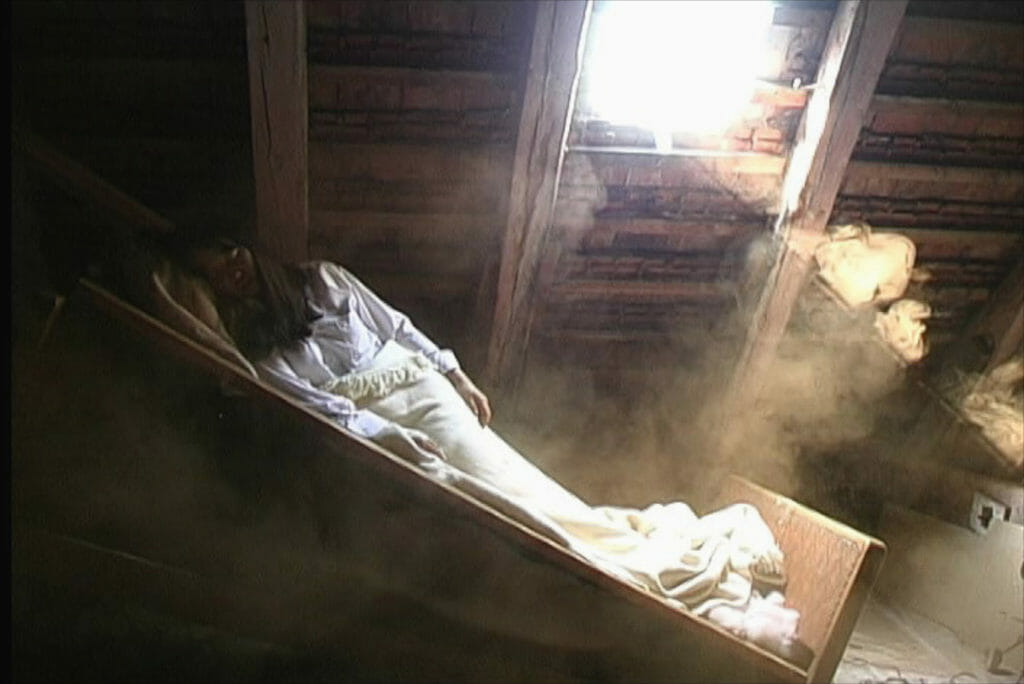
Paul McCarthy, a distinguished American artist, has gained renown for his multifaceted and often thought-provoking and unsettling body of work. His artistic repertoire encompasses a broad spectrum, spanning performance, photography, film, multimedia installations, sculpture, drawing, and painting. Renowned for his audacious and controversial approach, McCarthy’s creations frequently challenge societal conventions, delving into themes of consumerism, popular culture, and the depths of our innermost anxieties. His oeuvre delves into complex subjects, including sexuality, bodily fluids, and human orifices, boldly confronting the boundaries of taboos.
A prevailing characteristic of McCarthy’s art is his candid exploration of various icons from popular culture and childhood, such as Santa Claus, Barbie, Snow White, and Heidi. In his hands, these familiar figures are metamorphosed into malevolent, maleficent, and violent entities. McCarthy’s career, spanning an impressive five decades, has solidified his reputation as a preeminent chronicler and subverter of contemporary societal norms. His subversive work relentlessly mocks authority and societal conventions, blurring the lines between high and low culture, and forcing a critical evaluation of deeply entrenched beliefs.
Born in Salt Lake City in 1945, Paul McCarthy resides and creates in Los Angeles, California. His influential solo exhibitions have been held at esteemed institutions including KODE, Bergen (2021), Hammer Museum, Los Angeles (2020), Museum of Fine Arts Leipzig (2018), M Woods, Beijing (2018), Faurschou Foundation in Venice, Venice (2017), Fundació Gaspar, Barcelona (2017), Kulturzentrum Lokremise, St.Gallen (2016), The Renaissance Society, Chicago (2015), Monnaie de Paris, France (2014), Neue Nationalgalerie, Berlin (2012), Whitney Museum, New York (2008), SMAK, Ghent (2007), Moderna Museet, Stockholm (2006), and Haus der Kunst, Munich (2005). He has also been an active participant in esteemed international events, including the Berlin Biennial (2006), the Whitney Biennial (1995, 1997, 2004), and the Venice Biennale (1993, 1999, 2001).[13]
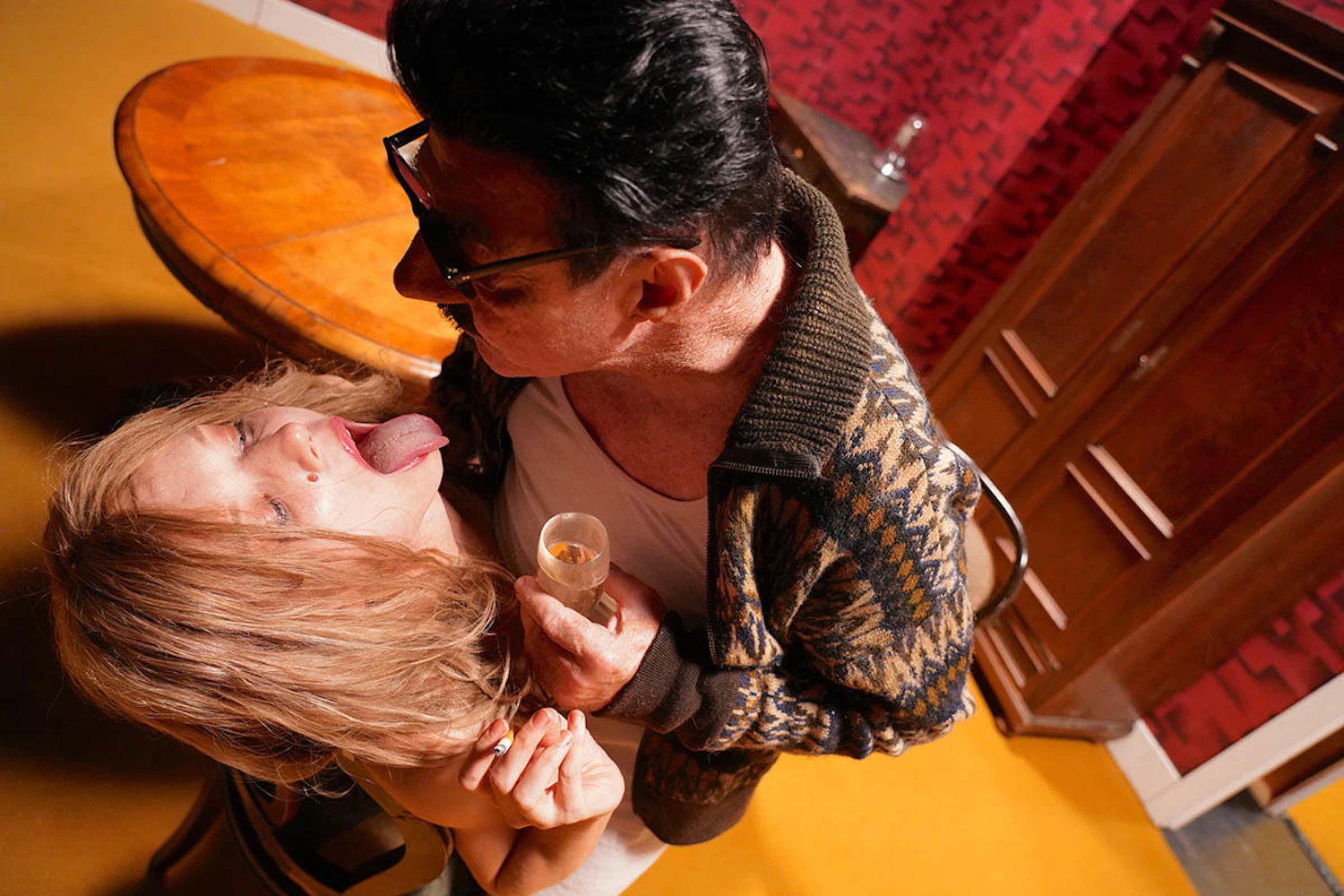
Allora & Calzadilla, a collaborative artist duo, engages in a nuanced and research-driven artistic practice that critically delves into the intricate intersections and complexities between cultural, historical, and geopolitical spheres. This interdisciplinary approach resonates through their diverse body of work, which encompasses performance, sculpture, sound, video, and photography. Operating from their base in Puerto Rico, their artistry resonates with themes of temporality, movement, and dreams, demanding an immersive engagement from viewers that is both intellectual and emotional.
The artists’ distinctive method of intervention fuses an expanded spectrum of artistic mediums, navigating seamlessly between the conceptual and the material, the metaphorical and the literal. Think of their performance at the Museum of Modern Art in which the artists carved a hole in a piano to place the pianist in the middle, playing the famous Fourth Movement of Beethoven’s Ninth Symphony.
Allora & Calzadilla’s explorations encompass a wide range of subjects. They have scrutinized the ephemeral nature of collective drawing using monumental chalk sticks at the Biennial de Lima, Peru (Chalk [Lima], 1998–2002); investigated the imprints of colonial, nationalist, and military violence on Vieques, Puerto Rico’s diverse populations and landscapes (Land Mark (Foot Prints), 2001–2002; Land Mark, 2003; Returning a Sound, 2004; Under Discussion, 2006; Half Mast/Full Mast, 2011); probed the resonances of music across different historical epochs (Clamor, 2006; Wake Up, 2007; Sediments Sentiments- Figures of Speech, 2008; Stop, Repair, Prepare: Variations on Ode to Joy for a Prepared Piano, 2008; Raptor’s Rapture, 2012; Apotomē, 2013; 3, 2013); and explored the intricate relationships between biophysics, semiotics, and reality (Growth, 2004; Puerto Rican Light – Cueva Vientos, 2015).[14]

Born in 1938 in Ardning, Austria, Günter Brus has carved a niche for himself through his groundbreaking films, audacious performances, and thought-provoking paintings. Notably affiliated with the Viennese Actionist Group, alongside fellow artists Otto Muehl and Hermann Nitsch, Brus has provocatively reshaped artistic boundaries and ignited discourse through his distinctive body of work.
He was catalyzed by a deep admiration for the paintings of Jackson Pollock, which ultimately spurred his evolution into crafting performance-based paintings centered on his own corporeal self. Brus found his artistic voice within the radical Viennese Actionist Group. This avant-garde collective, of which he was a significant member, sought to transcend conventional artistic paradigms through their daring and often controversial works. Their performances, films, and expressions encompassed a fusion of elements that defied the status quo.
Brus’s artistic ethos is underscored by his own words: “Pure painting or the art of drawing whose point of departure is based on purely formal criteria is, in my opinion, passé.” His 1968 performance “Kunst und Revolution” is a testament to this ethos. This seminal act involved him consuming his own urine, engaging in public masturbation, and inducing vomiting—an act that earned him a six-month imprisonment.[15]

Born in 1978 in Hamilton, Canada, Kapwani Kiwanga is a multidisciplinary artist residing and working in Paris, France. The Franco-Canadian artist’s work resonates as a testament to her profound exploration of power imbalances, intertwining historical narratives with contemporary realities, archives, and the boundless potential of tomorrow. Driven by research and a commitment to amplify marginalized or forgotten histories, Kiwanga’s creative expressions span diverse media, including sculpture, installation, photography, video, and performance.
Her artistic methodology ingeniously re-appropriates established canons and power structures, deftly challenging and redefining their foundations. Kiwanga’s oeuvre, characterized by what she aptly terms “exit strategies,” invites viewers to adopt multiple perspectives, prompting them to reconsider existing constructs and chart innovative paths for navigating the future. In the year 2020, Kiwanga achieved the esteemed accolade of the Prix Marcel Duchamp (FR), a recognition that attests to her exceptional contributions to the art world. Her talent was previously acknowledged by the Frieze Artist Award (USA) and the prestigious annual Sobey Art Award (CA) in 2018.
Kapwani Kiwanga’s artistic footprint extends through a rich array of solo exhibitions hosted by internationally renowned venues, including the Haus der Kunst in Munich (DE), Kunstinstituut Melly – Center for Contemporary Art in Rotterdam (NLD), Kunsthaus Pasquart in Biel/Bienne (CHE), MIT List Visual Arts Center in Cambridge (USA), Albertinum museum in Dresden (DE), Artpace in San Antonio (USA), Esker Foundation in Calgary (CA), Tramway as part of the Glasgow International (UK), Power Plant in Toronto (CA), Logan Center for the Arts in Chicago (USA), South London Gallery in London (UK), and the esteemed Jeu de Paume in Paris (FR), among other illustrious venues.[16]
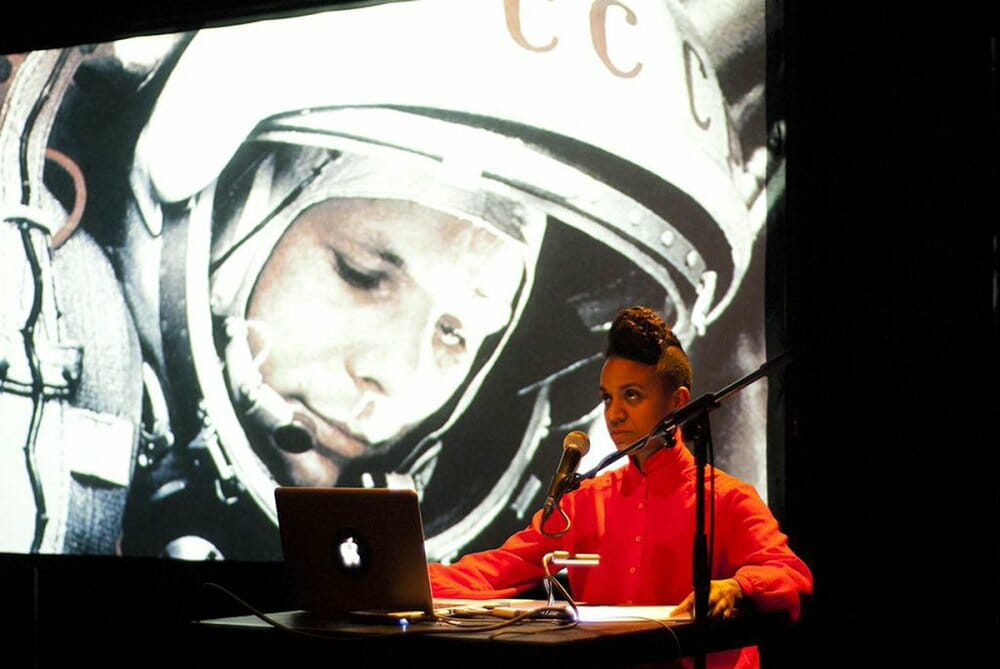
Dora García, born in Valladolid, Spain, in 1965, is a prominent artist who currently resides and works in Oslo, Norway. She employs the exhibition space as a dynamic platform to delve into the intricate relationships between visitors, artworks, and the environment. A proponent of interactivity and performance, García uses these elements to investigate the intersections of human interaction and creative expression. Her exceptional talent earned her the honor of representing Spain at the 54th Venice Biennale in 2011.
García’s artistic journey is grounded in the utilization of text, archives, and audio files to construct narratives that blur the boundaries between actuality and fiction. Her artistic mission involves questioning and challenging societal norms. Her diverse body of work, spanning video, writing, performance, and installation, actively redefines the conventional rapport between art pieces and spectators within the exhibition space. Melding elements of fiction and reality to a point of ambiguity, García’s art engenders unique situations that are both intellectually stimulating and playful. Her creations hinge on the active, and at times obligatory, involvement of the audience in the inception, activation, or even dissolution of the artwork.
García’s exhibitions have graced prestigious venues worldwide, including Museo Nacional Centro de Arte Reina Sofía, Madrid; Fondation d’Entreprise Hermes, Brussels; Power Plant Contemporary Art Gallery, Toronto; Fonderie Darling – Centre d’Arts Visuels, Montreal; Centre Georges-Pompidou, Paris; to name just a few. García has showcased her artistry at prominent international events, including the 54th, 55th, and 56th Venice Biennale (Italy), (d)OCUMENTA 13 (Kassel), 2nd Athens Biennale (Greece), Lyon Biennale (France), 29th São Paulo Biennial (Brazil), 16th Biennale of Sydney (Australia), 10th Lyon Biennial Gwangju Biennial (Korea), and numerous others.[17]
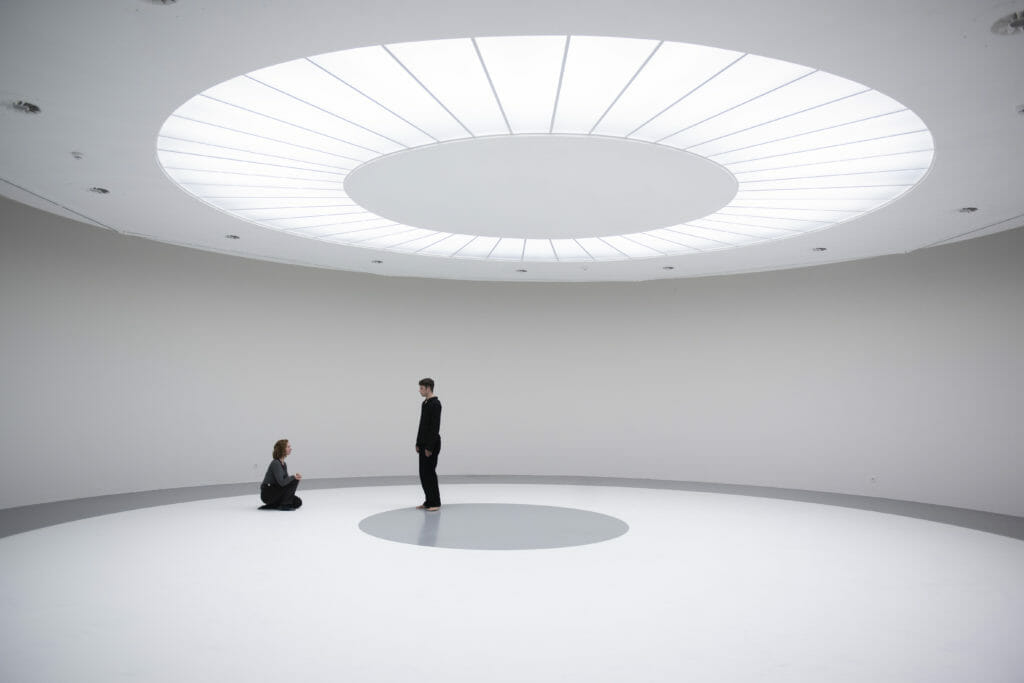
Teresa Margolles, born in 1963 in Culiacán, Sinaloa, Mexico, is an artist with a career spanning over twenty-five years, marked by an exploration of both the social and aesthetic dimensions of conflict. Her extensive body of work includes sculptural installations, photographs, films, and performances, all bearing the material traces of death. Margolles consistently integrates physical remnants from violent crimes resulting from political corruption and social exclusion into her art. These remnants, such as blood-stained sheets, shattered glass shards, bullet-ridden walls, and used surgical threads, serve to shed light on victims who often remain unseen and overlooked.
By blending aspects of conceptualism and minimalism, Margolles disrupts the norm by incorporating post-mortem matter—often concealed from public view—into the structures of civic and cultural institutions. Examples of her work include filling a white-cube gallery space with vaporized water used to wash corpses or displaying a flag spattered with blood from homicides near the Mexico-U.S. border on the façade of the Venice Biennale’s Palazzo Rota-Ivancich, and cleaning the floor with a mixture of water and blood from people murdered in Mexico at least once daily for the duration of the 2009 Venice Biennale. Through these audacious interventions, Margolles commands attention and demands accountability.
Margolles has received numerous awards, including the Artes Mundi Prize and the Prince Claus Award for Culture and Development in 2012. She represented Mexico at the 53rd Venice Biennale in 2009 and received a special jury mention at the 58th Venice Biennale in 2019. Her works are part of esteemed permanent collections worldwide, including institutions like Castello di Rivoli Museo d’Arte Contemporanea in Torino, Italy; Centre Georges Pompidou in Paris, France; Museo Tamayo Arte Contemporáneo in Mexico City, Mexico; and Tate Modern in London, the United Kingdom, among others.[18]
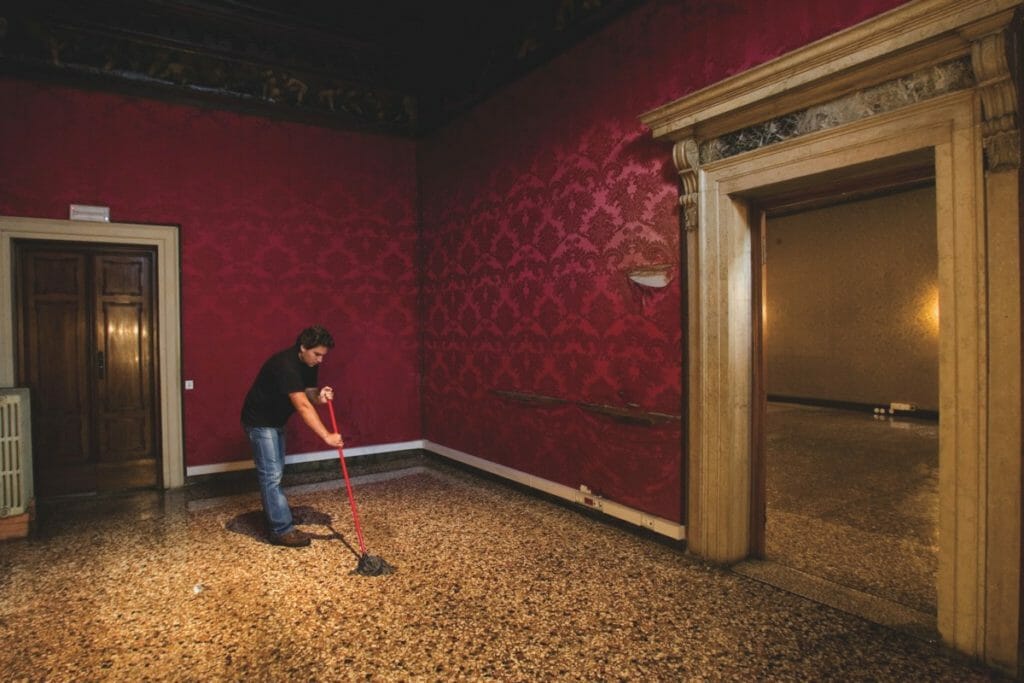
Joan Jonas, born in 1936 in New York, where she continues to reside and work, is a pivotal figure in pioneering Video and Performance Art. Her artistic journey, which commenced in the 1960s, is marked by the profound placement of female subjectivity at its core, encompassing gestures, storytelling, and dynamic imagery. With an insatiable spirit of experimentation, Jonas dives deep into the interdisciplinary nature of art.
Throughout her career, she has engaged in dynamic collaborations with Peter Campus and Richard Serra, performer Ragani Haas, and musicians Alvin Curran and Jason Moran. This unceasing exploration has seen Jonas draw from an eclectic array of sources, from fairy tales to essays, myths to local folklore, all the while recontextualizing them in contemporary life, blending the poetic and the political.
Institutions across the globe have embraced the work of Joan Jonas through solo exhibitions, including Haus der Kunst in Munich, Germany, and Dia Art Foundation in Beacon, New York, to name just a few. In 2015, Joan Jonas represented the United States at the 56th Venice Biennale. Her artistry has also graced the prestigious Documenta exhibitions in Kassel, Germany, specifically Documenta V, VI, VII, VIII, XI, and XIII. In 2019, she received the esteemed Kyoto Prize, followed by the Solomon R. Guggenheim Museum’s inaugural Lifetime Achievement Award in 2009.[19]
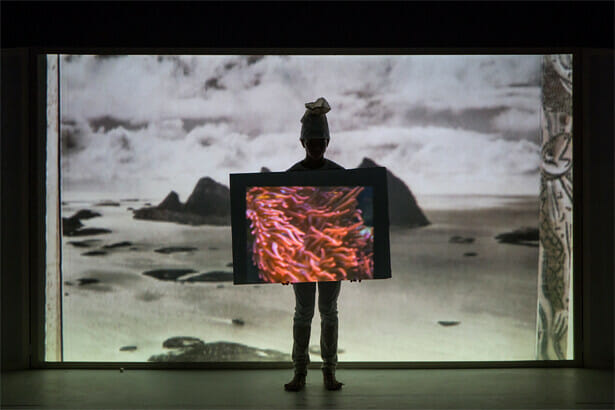
Hermann Nitsch was renowned for his multifaceted creative practice, which seamlessly bridged various artistic disciplines including performance art, painting, musical composition, and beyond. His journey as an artist commenced during the 1950s when he received his training at Vienna’s Graphische Lehr- und Versuchsanstalt, setting the stage for his remarkable contributions to the avant-garde scene in Vienna during the 1960s and 1970s. During the initial stages of his painting career, Nitsch experimented with Action paintings, employing techniques like splattering paint onto canvases. Some of his works from the 1960s also integrated fabric and blood, infusing them with a visceral and emotive quality.
Within the vibrant milieu of the Viennese Actionism movement, Nitsch orchestrated daring and provocative performances that left an indelible mark on the art world. These performances often pushed boundaries, incorporating unconventional materials such as blood, flesh, and more. In a profound manner, Nitsch’s work in both performance and painting evolved into a quasi-religious practice, with his concept of the famed Orgies Mysteries Theatre taking root in the 1950s. This expansive and sensorial performance eventually materialized as the monumental 6-Day-Play. Furthermore, Nitsch’s artistic journey extended to printmaking as he delved further into of the human body, referring to it as “the architecture of the O.M. Theatre” since the 1970s. In the 1990s, he innovatively introduced paint and blood splashes into his printing process, establishing a profound dialogue between his works on canvas and his graphic prints.
Over the course of his illustrious career, Hermann Nitsch exhibited at esteemed institutions across the globe, including the Centre Pompidou in Paris, France; the Moderna Museet in Stockholm, Sweden; the Leopold Museum and the Albertina Museum in Vienna, Austria; among others. His groundbreaking performances transcended borders, captivating audiences in Vienna, New York, London, Havana, Leipzig, Hobart, and various other international venues.[20]
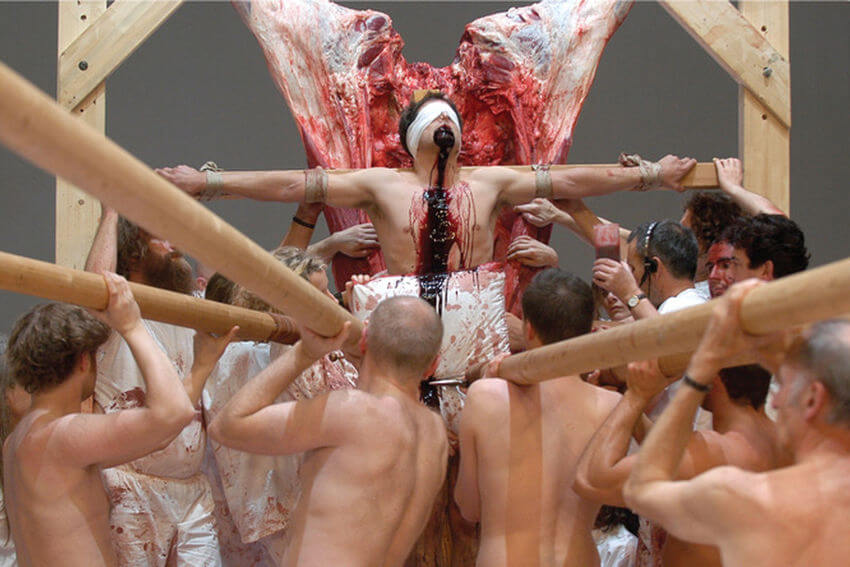
Yves Klein, born in 1928 in the picturesque city of Nice, France, studied at the École Nationale de la Marine Marchande and the École Nationale des Langues Orientales Vivantes from 1942 to 1946. Initially, Klein’s vocational pursuits led him into the world of judo, where he attained the highest honor in this martial art and spent a transformative fifteen months in Japan. However, it wasn’t until his return to Paris in 1954 that he wholeheartedly dedicated himself to art, embarking on what he would later call his ‘adventure into monochrome.’
Yves Klein’s immensely influential career, although tragically brief, spanned just seven years before his untimely passing at the tender age of 34 in 1962. As a prominent figure best known for his International Klein Blue works, his practice blurred the lines between Conceptual Art, sculpture, painting, and performance. Klein aimed to make the absolute visible, in search to express emotions without restrictions. His monochromatic bluer-than-blue sculptures and paintings are as iconic as his performances. Think of the Antropometries in which he painted with naked female bodies covered in blue paint.
Yves Klein’s work features in the most esteemed institutions of the world, including the Guggenheim Museum and the Museum of Modern Art in New York, the United States of America; the Städel Museum in Frankfurt, Germany; the Calderara Foundation Collection in Milan, Italy; and many others. Notable retrospective exhibitions include at the Musée national d’Art Moderne and the Centre Georges Pompidou in Paris, France; the Nice Modern and Contemporary Art Museum in Nice, France; the Luigi Pecci Contemporary Art Museum of Prato, Italy; and others.[21]

Michelangelo Pistoletto, born in Biella in 1933, best known for his mirror paintings, creative collaborations, Arte Povera, and even theatre—with performance lurking around the corner of almost every artistic venture. From smashing his mirror paintings with a hammer, creating a “zoo” of people from various disciplines, or creating a walking sculpture in which a large spherical object of newspaper is being carried, driven, and walked through a city center.
“Pistoletto is an ardent advocate of the performative in art — both in his conceptual sculptures and figurative mirror paintings. The performance of the viewer entering the picture when becoming its spectator, or the artist, smashing his mirrors into thousands of pieces. Interactivity and spontaneity are crucial in the Italian artist’s practice. But also the duality of conceptualism and figurative representation, encompassing almost seven decades of art, making Michelangelo Pistoletto one of the most influential artists of his time.” (Source: Artist feature Michelangelo Pistoletto)
The Italian artist’s practice is project-based, often dedicating multiple years to a single project and including different actors and the viewer directly. His Pistoletto remarkable contributions to the art world earned him the Venice Biennale’s Golden Lion for Lifelong Achievement in 2003, followed in 2004, the University of Turin bestowed upon him an honorary degree in Political Science, and in 2007, the Wolf Foundation Prize in the Arts in Jerusalem, honoring his inventive career as an artist, educator, and activist, which contributed to a deeper understanding of the world.[22]
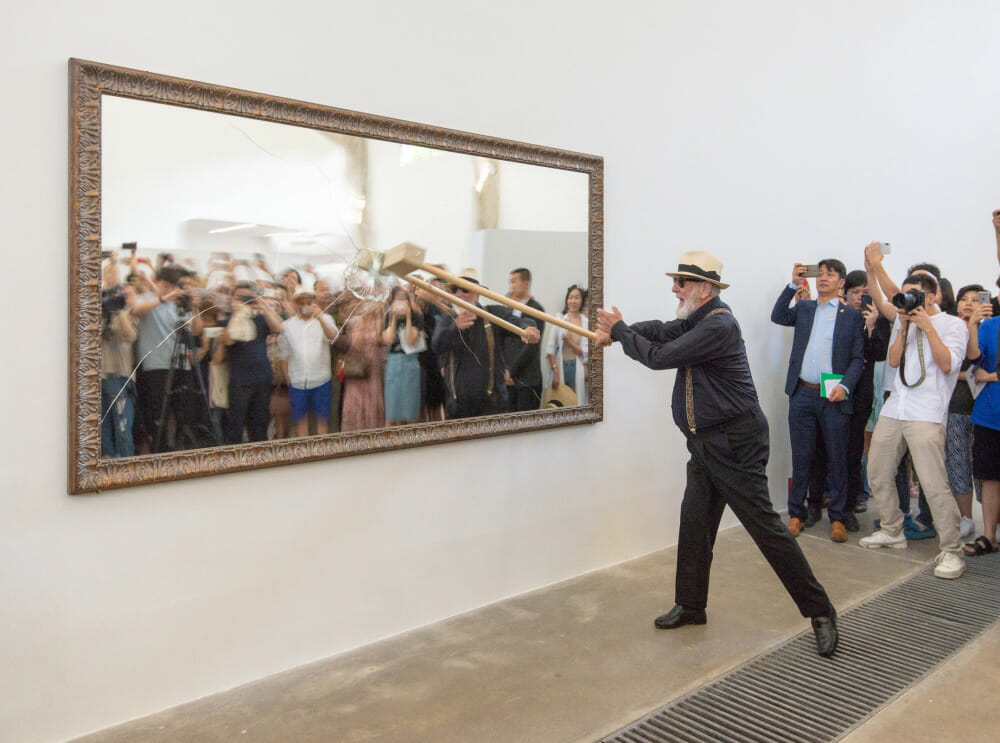
Otobong Nkanga, born in 1974 in Kano, Nigeria, is an artist whose work is deeply rooted in ecological themes, emphasizing interconnectedness and transformation through poetics of entanglement. Her expansive practice, spanning multiple disciplines, delves into social, political, and material relationships among bodies, territories, minerals, and the Earth itself. Nkanga’s art challenges conventional distinctions between minimalism and conceptualism, as well as the boundaries separating the sensual from the surreal. Her research-based approach weaves together humans and landscapes, organic and non-organic matter, and the economies of the Global North and Global South.
Through a diverse array of mediums, including drawing, installation, performance, photography, textiles, and sculpture, Nkanga constructs pathways that translate the natural world—encompassing plants, herbs, minerals, and living organisms—into interconnected scenarios that evoke memories, labor, home, care, ownership, emotion, touch, and scent. In addition to creating distinct and meticulously researched art objects, Nkanga is known for her ambitious, long-term projects, reflecting on transhistorical and cross-cultural influences, underscoring the global scope of her artistic inquiries.
By reimagining people and objects as complex entities interwoven with other entities, Nkanga skillfully integrates insights from geology, botany, poetry, and non-Western knowledge systems into her work. Nkanga’s recent solo exhibitions have been featured at prominent venues worldwide, including the Sint-Janshospitaal in Bruges, Belgium; Kunsthaus Bregenz in Austria; Castello di Rivoli Museum of Contemporary Art in Turin, Italy; and Villa Arson in Nice, France; to name just a few. Notable recognitions include a Special Mention Award at the 58th International Art Exhibition of La Biennale di Venezia in Italy and the Young Belgium Art Prize in 2017. Her work reflects a profound commitment to exploring the intricate relationships between humanity and the natural world, offering a profound vision of interconnectedness and possibilities for a more sustainable future.[23]
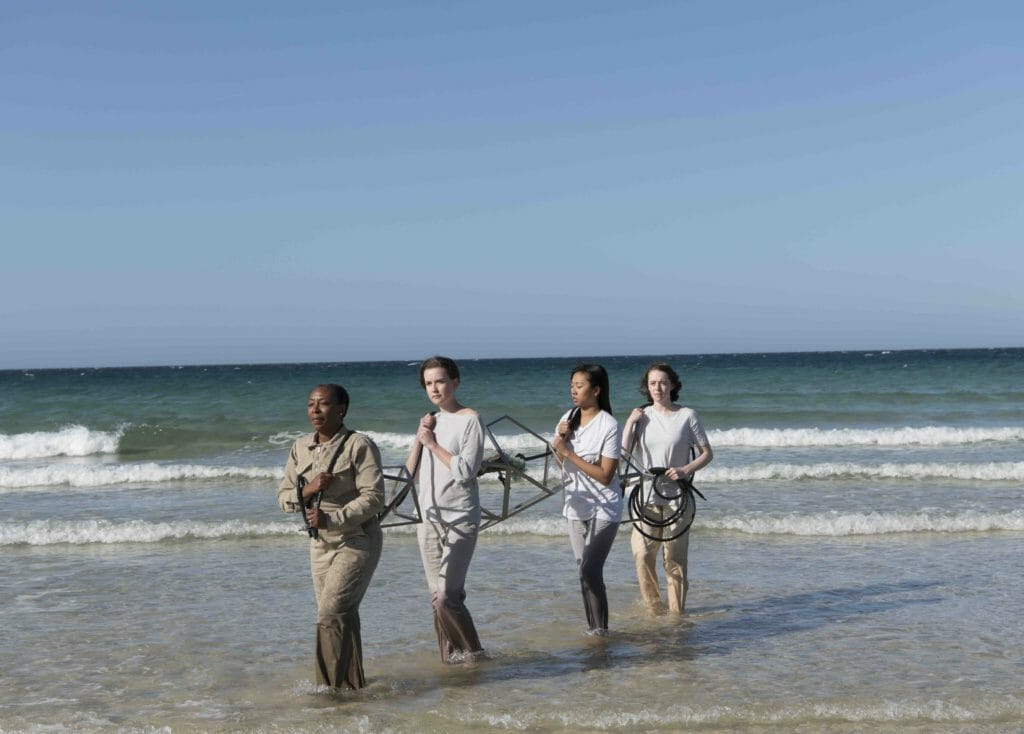
Martha Rosler is a Brooklyn-based art world icon, with an artistic practice spanning various mediums, including video, photography, text, installation, and, of course, performance. Rosler’s art delves into the public sphere and the everyday, both tangible and virtual, with a particular focus on their impact on women.
She engaged in creating art that explores the intersection of domestic life and the broader context of war and national security. Her photomontage series, in particular, has played a pivotal role in her examination of these themes. We encounter a similar perspective in her performance pieces, think of the Semiotics of the Kitchen (1975)—a parodic cooking demonstration in which the gestures with the kitchen tools depart from the normal use, discussing frustration and oppression.
Her artistic career has been marked by solo exhibitions at prominent institutions both in the United States and internationally, such as the Museum of Recent Art in Bucharest, Romania; Tate Modern in London, the United Kingdom; Museo de Arte Contemporáneo in Santiago, Chile; or the Museum of Modern Art in New York, the United States of America; among others. In recognition of her significant contributions to the field of art, she received the Guggenheim Museum Lifetime Achievement Award in 2010, among many other honors and awards. Martha Rosler’s work continues to engage with pressing societal issues and captivate audiences around the world.[24]
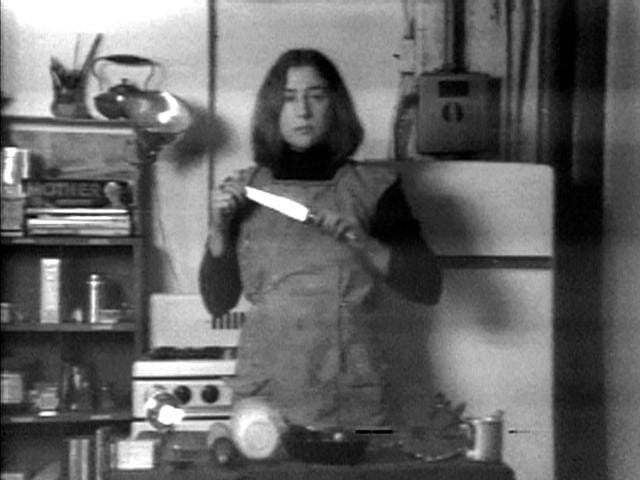
Born in Tokyo, Japan, in 1933, residing and working in the vibrant artistic hub of New York City, Yoko Ono is a multimedia artist known for a diverse body of work spanning performance, instructions, film, music, and writing. Ono made a pivotal move to New York in 1953 following her studies in philosophy in Japan. By the late 1950s, she had become an integral part of the city’s vibrant avant-garde scene. In 1960, she opened her Chambers Street loft, which served as a platform for a series of radical performance works and the realization of her early conceptual pieces.
Yoko Ono aims to include the audience into her artistic process and execution; think of her Instruction Paintings, inviting the audience to tread on canvas instructed by text, and—arguably her most iconic performance to date, Cut Piece (1964) where she invites random audience members to approach her and cut her cloths with a pair of scissors until she most completely naked. The performance is about giving and taking, but also an analogy towards the Hiroshima bombing and, indirectly, it has also become of the most iconic feminist performance pieces.
Over the years, Yoko Ono has been featured in numerous museum exhibitions, including traveling shows organized by the Museum of Modern Art Oxford and the Japan Society in New York.In 2009, shes exhibited at the Bevilacqua Foundation in Venice, where she received the prestigious Golden Lion for Lifetime Achievement from the Venice Biennale. In 2013, a comprehensive survey of Yoko Ono’s work was featured in Australia at the Museum of Contemporary Art Australia in Sydney. [25]
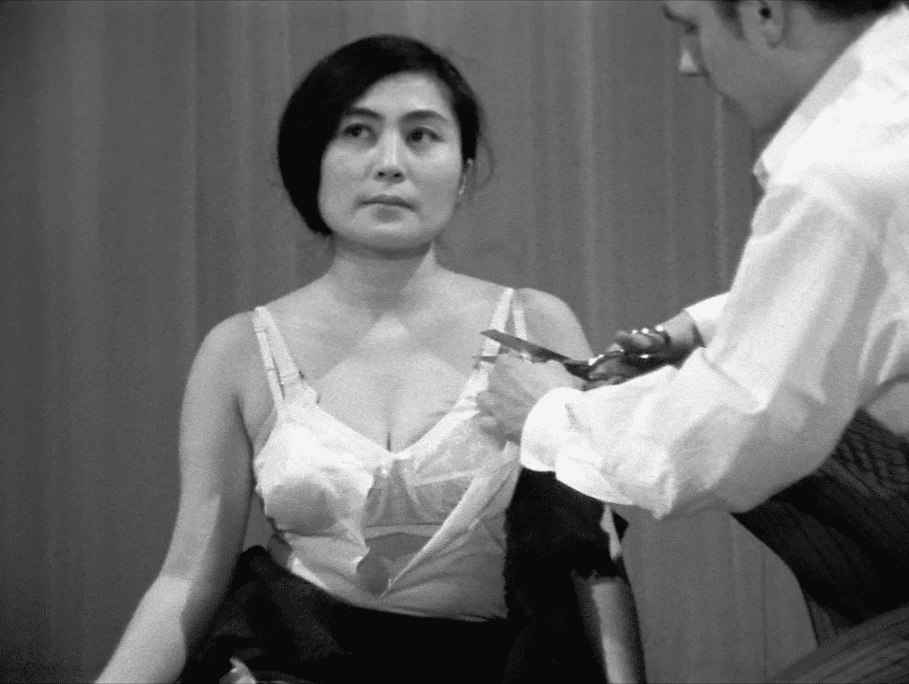
Marina Abramović is a true pioneering figure in the world of Performance Art. In the early 70s, her groundbreaking work laid the foundation for the evolution of performance into a recognized visual art form. Early in her career, she introduced groundbreaking and notorious pieces like “Rhythm 0” (1974), where she offered herself as an object of experimentation to the audience, and “Rhythm 5” (1974), during which she lay within a burning five-point star to the point of losing consciousness. These performances blended conceptual ideas with physicality, endurance with empathy, complicity with a loss of control, and passivity with danger. They explored self-discovery, not only for herself but also for her audience, while delving into concepts of time, stillness, energy, pain, and heightened consciousness through long-duration performances.
Marina Abramović’s body has perpetually been both her subject and her medium. She has undertaken performances that ritualize the everyday actions of life, pushing her physical and mental limits, enduring pain, exhaustion, and danger in her quest for emotional and spiritual transformation. From 1975 to 1988, she collaborated with the German artist Ulay, exploring themes of duality in their work. In 1989, she returned to solo performances—which in 2010, resulted in one of the most significant milestones in her career with The Artist Is Present, where Abramović sat motionless for hours each day over three months, engaging in silent eye-contact with numerous strangers individually, before being moved by seeing Ulay once more, having grown apart for 22 years.
Marina Abramović’ has been featured in solo exhibitions at various locations, including Istanbul, Athens, São Paulo, London, Malaga, New York, Moscow, Vienna, Milan, and more. She has actively participated in large-scale international exhibitions such as the Venice Biennale and Documenta in Kassel, Germany. Furthermore, she has established the Marina Abramović Institute (MAI), dedicated to supporting the exploration and promotion of performance art in the future.[26]
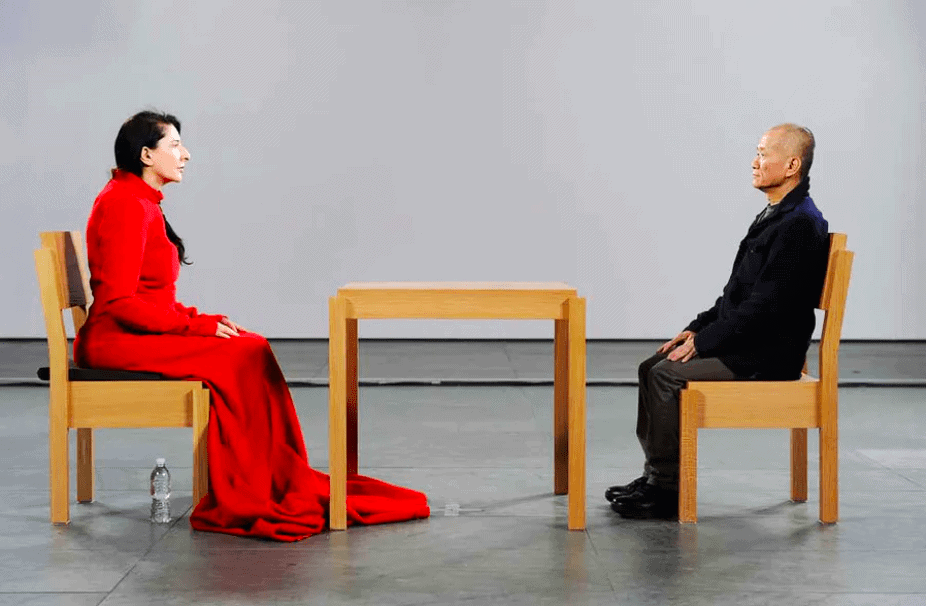
Francis Alÿs, a Belgian artist born in Antwerp in 1959, has consistently channeled his unique poetic and imaginative sensibility into addressing anthropological and geopolitical concerns, often focusing on observations of everyday life. His artistic practice, which encompasses a wide range of media such as installation, video, painting, and drawing, and public actions as performance, is characterized by its exploration of these themes through what he describes as “a sort of discursive argument composed of episodes, metaphors, or parables.”
Throughout his career, Alÿs has engaged in multifaceted projects that often involve thought-provoking actions. These actions include traversing the longest possible route between locations in Mexico and the United States, pushing a melting block of ice through city streets, commissioning sign painters to replicate his paintings, filming his attempts to enter the center of a tornado, carrying a leaking can of paint along the Israel/Palestine border, and orchestrating the movement of a massive sand dune by ten centimeters. No matter how absurd some of these performative actions might seem at first, they are rooted in a philosophical argument, socio-political issue, or symbolic narrative.
Alÿs’s work has been featured in numerous solo and group exhibitions at prestigious institutions worldwide. Some of his recent exhibitions include “Francis Alÿs: Children’s Games, 1999-2022” at the Museo Universitario Arte Contemporáneo in Mexico City, representing Belgium at the 59th Venice Biennale with “Francis Alÿs: The Nature of the Game,” and solo exhibitions at Copenhagen Contemporary and the Musée cantonal des Beaux-Arts in Lausanne, Switzerland. His art has been widely recognized for its thought-provoking exploration of social and geopolitical issues, and his work is held in public collections in museums around the world.[27]
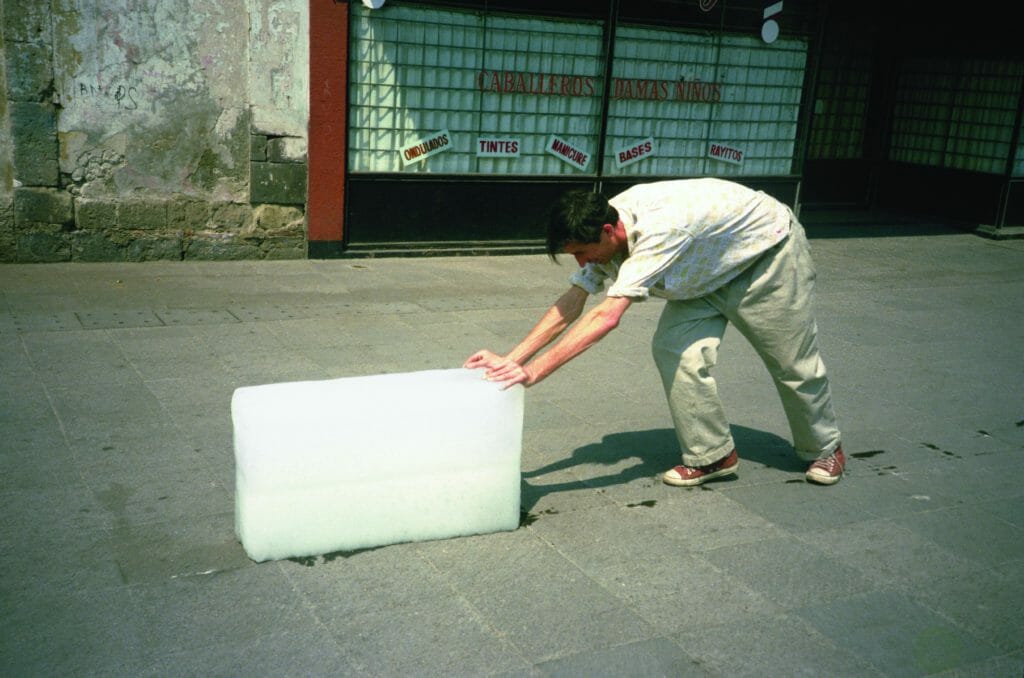
Born in 1940 in Linz, Austria, Waltraud Hollinger changed her name to VALIE EXPORT—all uppercase letters—and introduced her self to the Viennese art scene aged twenty-eight. She is a pioneering figure in the realms of film, video, and installation art, crafting one of the most influential bodies of feminist art in the post-war era. Her revolutionary work in the 1960s and 1970s introduced Europe to an entirely new paradigm of radical feminism, one deeply rooted in the physicality of the body and its intricate relationship with environment, culture, and society.
Notably, she spearheaded the ‘Expanded Cinema’ practice, employing her own body as a medium of artistic expression, firmly situating her among the early performance art luminaries such as Joseph Beuys and Allan Kaprow. Central to EXPORT’s oeuvre is her exploration of the self as a representation, provoking contemplation on the body’s role as a signifier and conveyor of information. Her work challenges audiences by scrutinizing the politics of eroticism, the male gaze, and liberation—think of her iconic Tap and Touch performances (1968-1971), allowing strangers on the street to touch her breasts publicly.
VALIE EXPORT currently resides and works in Vienna, where she co-founded the Austrian Filmmakers Cooperative. Since 1968, she has featured prominently in numerous international exhibitions, including documenta 6 and 12 (1977 and 2007) and the Austrian Pavilion at the Venice Biennale in 1980. In 2015, the VALIE EXPORT Center Linz was established, serving as a dedicated hub for the study of media and performance art, preserving her legacy and facilitating international research in this field.[28]

Mona Hatoum was born into a Palestinian family in Beirut, Lebanon, in 1952, and she has been based in London since 1975. The artist intertwines poetry and politics, delving into various artistic mediums encompassing performance, installations, sculpture, video, photography, and works on paper.
Her artistic journey commenced in the 1980s, marked by visceral video and performance art that explored the human body in profound ways. Yet, from the early 1990s onward, Hatoum increasingly embarked on creating large-scale installations designed to immerse the viewer in a whirlwind of conflicting emotions, juxtaposing desire with revulsion, and fear with fascination.
Mona Hatoum has actively participated in numerous group exhibitions worldwide, including significant events such as Documenta 14 in Kassel, Germany, and Athens (both 2017); the 6th Marrakesh Biennale (2016); the 5th Moscow Biennale; and the Guggenheim Bilbao, Spain (both 2011), further solidifying her presence on the international art scene. Her accolades include the Praemium Imperiale (2019), the 10th Hiroshima Art Prize (2017), and the Joan Miró Prize (2011), among other honors.[29]

Born in Matsumoto, Japan, in 1929, Yayoi Kusama‘s impressive oeuvre spans across a wide spectrum of artistic mediums, encompassing painting, performance, immersive installation, outdoor sculpture, literary work, film, fashion, design, and interventions within architectural structures. Kusama’s art navigates the realms of both microscopic and macroscopic universes, offering a unique artistic perspective, marked by vivid color, pumpkins, polka dots, and infinity.
Kusama’s most important performances are often associated with her involvement in the 1960s art scene, particularly in New York City. During this period, she staged various happenings and events that were both groundbreaking and influential. One of her notable performances is the “Body Festival” held in 1967, where she organized a series of public gatherings and events involving participants painted with polka dots, a recurring motif in her work. These events blurred the boundaries between art and life, inviting active participation from the audience. Or what about her Self-Obliteration performance during the very same year, where visualizes being lost and overwhelmed by the panic and feeling of infinite polka dots.
Kusama’s art can be found in museum collections worldwide, including institutions such as the Art Gallery of Ontario, Toronto; Centre Georges Pompidou, Paris; Hirshhorn Museum and Sculpture Garden, Washington, DC; Los Angeles County Museum of Art; The Museum of Modern Art, New York; National Museum of Modern Art, Tokyo; Stedelijk Museum, Amsterdam; Tate, London; Walker Art Center, Minneapolis, Minnesota; and the Whitney Museum of American Art, New York, among many others. Yayoi Kusama currently resides and works in Tokyo.[30]
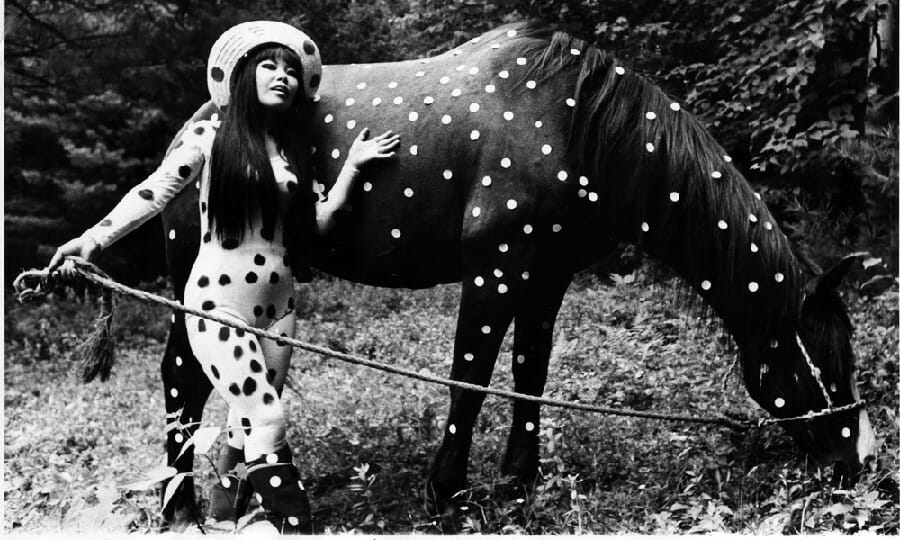
Born in Fort Wayne, Indiana, in 1941, Bruce Nauman reshaped the boundaries of art and introducing novel methodologies in his radical and interdisciplinary practice embracing a wide spectrum of mediums, including performance, video, holography, installation, sculpture, and drawing.
Since the 1960s, Bruce Nauman has fearlessly engaged with existential dichotomies, such as life and death, love and hate, pleasure and pain. His work delves into themes like the interplay between image and language, the dynamic between art and viewer, the generative interaction between positive and negative space, or the use of the body as material—in particular in his performances, think of his iconic Dance or Exercise on the Perimeter of a Square (Square Dance) and Walking in an Exaggerated Manner Around the Perimeter of a Square from 1967-1968.
Nauman’s impactful notable exhibitions include “Pay Attention: Bruce Nauman Videos from the Collection of Barbara Balkin Cottle and Robert Cottle” at the Scottsdale Museum of Contemporary Art, Arizona, in 2005. His work has been featured at various prestigious institutions worldwide, such as the Tate Liverpool in England, the Museum of Contemporary Art San Diego, California, the Museu de Arte Contemporanea in Portugal, and The Museum of Modern Art in New York, among others.[31]
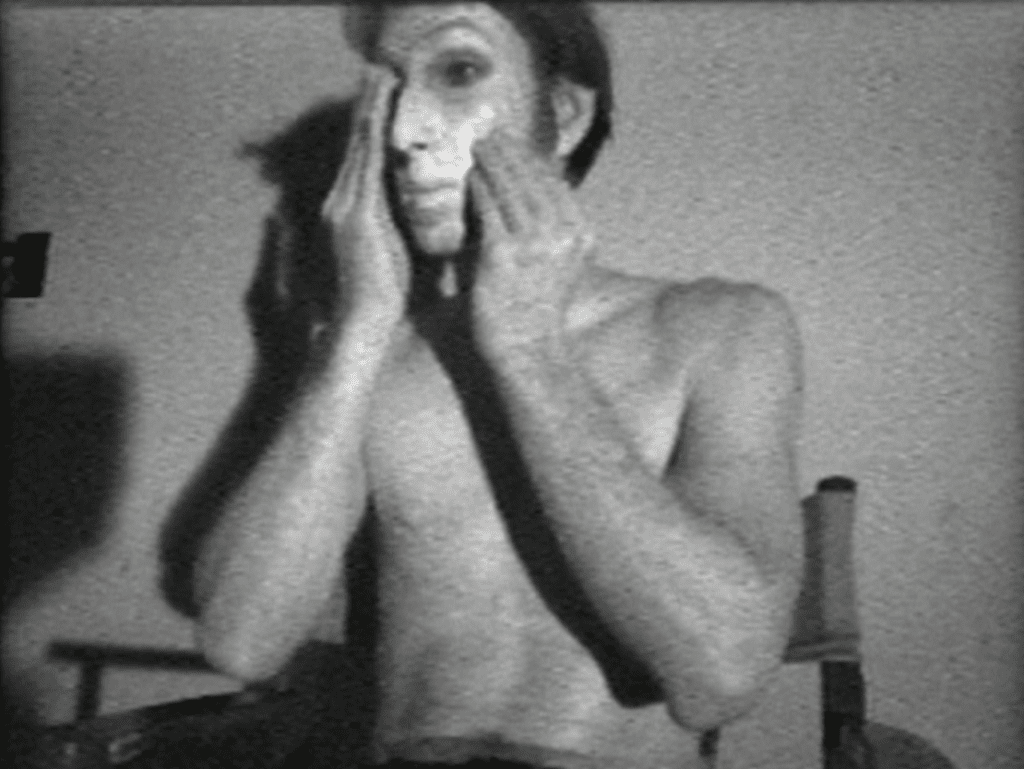
Born in Krefeld, Germany, in 1921, Joseph Beuys was one of the most prolific artists of his generation, anchoring his expansive body of work in the realms of humanism, social philosophy, and anthroposophy. In 1961, he was appointed professor of monumental sculpture at the Düsseldorf Art Academy where he became an influential and charismatic figure, inspiring a new generation of German artists, joining the Fluxus Group, and producing some of the most iconic pieces of Performance Art.
In 1965, he covered his head with honey and gold leaf and walked through an art gallery with a dead hare in his arms. He whispered and mumbled to the hare, explaining the artworks on display. The use of unconventional materials and the act of explaining art to a lifeless creature challenged the traditional role of the artist and the way art is perceived. In 1974, Beuys traveled to New York for this performance, where he spent three days in a room with a live coyote. He wrapped himself in felt and used a shepherd’s crook. The performance explored themes of isolation, communication, and the relationship between humans and nature.
His performances are absurd but witty, humorous yet disturbing, ridiculous and still genius. His monumental retrospective at the Solomon R. Guggenheim Museum in New York in 1979 solidified Beuys’s international renown. Following his passing in 1986, his art has continued to be showcased in numerous museum exhibitions worldwide, including prominent venues such as the Museo Nacional Centro de Arte Reina Sofia in Madrid, Centre Pompidou in Paris, Tate Modern in London, and the National Gallery of Victoria in Melbourne. In 2021, the centenary of Beuys’s birth was marked by an array of exhibitions, performances, lectures, and events celebrating his enduring legacy.[32]
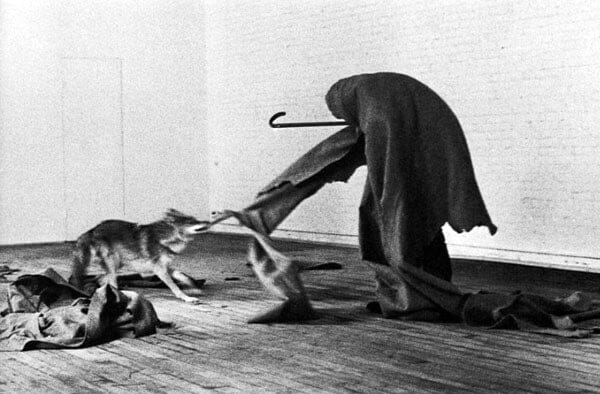
Notes:
[1] Artfacts, Performance at https://artfacts.net/media/performance-happening/38 consulted August 29, 2023.
[2] The introduction includes information from: IMMA, What is Performance Art? at https://imma.ie/what-is-art/series-1-1970-now/performance-art/ consulted August 29, 2023.
[3] Osart Gallery, Dennis Oppenheim at https://www.osartgallery.com/dennis-oppenheim?lang=en consulted August 30, 2023.
[4] Carolee Schneemann Foundation at https://www.schneemannfoundation.org consulted August 30, 2023.
[5] Levy Gorvy, Adrian Piper at https://www.levygorvy.com/artist/adrian-piper/ consulted August 30, 2023.
[6] Acconci Studio at https://acconci.com consulted August 30, 2023.
[7] MoMA, Wolf Vostell at https://www.moma.org/artists/6191 consulted August 31, 2023.
[8] Rebecca Horn, Biography at https://www.rebecca-horn.de/pages-en/biography.html consulted August 31, 2023.
[9] Luhring Augustine, Razgnar Kjartansson at https://www.luhringaugustine.com/artists/ragnar-kjartansson consulted August 31, 2023.
[10] Theaster Gates, About at https://www.theastergates.com/about consulted August 31, 2023.
[11] David Kordansky Gallery, John M Armleder at https://www.davidkordanskygallery.com/artist/john-armleder consulted August 31, 2023.
[12] Templon, Chiharu Shiota at https://www.templon.com/artists/chiharu-shiota-2/ consulted August 31, 2023.
[13] Xavier Hufkens, Paul McCarthy at https://www.xavierhufkens.com/artists/paul-mccarthy consulted August 31, 2023.
[14] Lisson Gallery, Allora & Calzadilla at https://www.lissongallery.com/artists/allora-and-calzadilla consulted August 31, 2023.
[15] Artnet, Günter Brus at https://www.artnet.com/artists/günter-brus/ consulted August 31, 2023.
[16] Goodman Gallery, Kapwani Kiwanga at https://www.goodman-gallery.com/artists/kapwani-kiwanga consulted August 31, 2023.
[17] Michel Rein, Dora Garcia at https://michelrein.com/artistes/presentation/3/dora-garcia consulted August 31, 2023.
[18] James Cohan, Teresa Margolles at https://www.jamescohan.com/artists/teresa-margolles2 consulted August 31, 2023.
[19] Galleria Raffaella Cortese, Joan Jonas at https://raffaellacortese.com/artist/joan-jonas/ consulted August 31, 2023.
[20] Pace, Hermann Nitsch at https://www.pacegallery.com/artists/hermann-nitsch/ consulted September 12, 2023.
[21] Opera Gallery, Yves Klein at https://www.operagallery.com/artist/yves-klein consulted September 12, 2023.
[22] Galleria Continua, Michelangelo Pistoletto at https://www.galleriacontinua.com/artists/michelangelo-pistoletto-61/biography consulted September 12, 2023.
[23] Lisson Gallery, Otobong Nkanga at https://www.lissongallery.com/artists/otobong-nkanga consulted September 12, 2023.
[24] Mitchel-Innes & Nash, Martha Rosler at https://www.miandn.com/artists/martha-rosler consulted September 12, 2023.
[25] Galerie Lelong & Co., Yoko Ono at https://www.galerielelong.com/artists/yoko-ono consulted September 14, 2023.
[26] Lisson Gallery, Marina Abramovic at https://www.lissongallery.com/artists/marina-abramovic consulted September 14, 2023.
[27] David Zwirner, Francis Alÿs at https://www.davidzwirner.com/artists/francis-alys consulted September 14, 2023.
[28] Thaddaeus Ropac, VALIE EXPORT at https://ropac.net/artists/41-valie-export/ consulted September 14, 2023.
[29] White Cube, Mona Hatoum at https://www.whitecube.com/artists/mona-hatoum consulted September 14, 2023.
[30] David Zwirner, Yayoi Kusama at https://www.davidzwirner.com/artists/yayoi-kusama consulted September 14, 2023.
[31] Gagosian, Bruce Nauman at https://gagosian.com/artists/bruce-nauman/ consulted September 15, 2023.
[32] Thaddaeus Ropac, Estate Joseph Beuys at https://ropac.net/artists/29-joseph-beuys-estate/ consulted September 15, 2023.
Last Updated on April 19, 2024

A Studio Visit During the La BIBI Residency
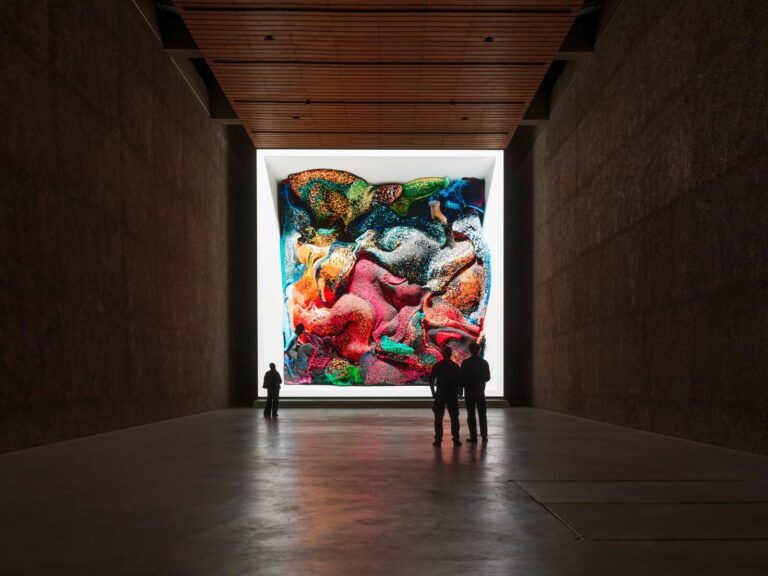
A Reasoned Anthology